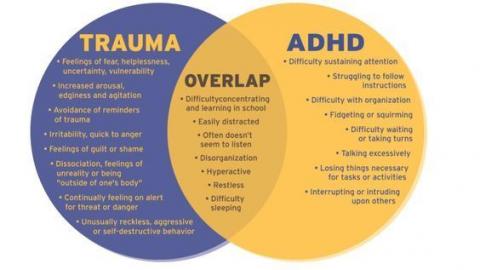


I hate the first week of school. It fills me with anxiety and dread. I once loved the smell of new crayons and was excited over the new backpacks and folders. Now I worry. I parent children from hard places; children who have experienced trauma. I’ve been lucky the last two years. I had a teacher that “got it”. I had a teacher that listened to me and studied up on trauma and it’s effects on the child’s brain. She understood that unaddressed trauma generates lifelong impacts that can end in early death.
Sound extreme?
It’s not.
Parenting my child is life or death and I decided to write this post to explain. I was once a 3rd grade teacher, so I know that you might be thinking this is all a bit dramatic. However, I am now the mother of 7 and I live with the effects of childhood trauma every day. These are the things that I understand as a mother, a former educator and a nurse.
Trauma impacts the children in your classroom.
We have sanitized trauma in our lives. Opioid crisis. Food insecurity. Sirens and fights in the night. We don’t really think about the smallest victims. We don’t read about the child hiding in the backroom during a drug bust, or the baby left in an apartment tended by his 11 year old sibling with only ramen and cereal to eat. Instead we protect anonymity to the detriment of these children who end up in the classroom struggling with a story that is never told. We end up treating the traumatized by ignoring the trauma.
If you are a teacher, you WILL teach children who have been traumatized. The CDC ACE study tells us that more than 50% of students in the classroom have experienced one or more adverse childhood events (ACE). The time in life when the brain is the most sensitive to experience is infancy and childhood.
In the CDC’s ACE Study, the ten types of childhood adversity measured were:
Trauma Changes the Brain
Studies show chronic stress or unaddressed ACEs can change the chemical and physical structures of the brain. In the classroom, children can display traumatic stress through aggression, anxiety, defiance, perfectionism, and withdrawal. And here’s the biggie, signs of trauma often times look very similar to ADD, ADHD, ODD and autism spectrum disorder.
Think on this…inattentive, hyperactive, and impulsive behavior may in fact mirror the effects of trauma or adversity. Children show their emotions through behavior.
What might seem like random, nonsensical or manipulative behaviors in a child, might actually be rooted in a space called ‘FEAR’ and pain. The emotional backpack they carry to school each day is one that they cannot set outside your classroom door, and it will remain heavy and forefront in their brain.
It’s important to understand that 25% to 50% of the students within your classroom, will be affected by adverse childhood events. Trauma undermines attention, executive functioning and working memory. When trauma causes emotional or psychological damage to children, they may adopt a set of behaviors or patterns of thinking that put them on a path for further trauma. Trauma begets trauma.
Your students who have experienced trauma in their lives are often operating from a primal state – always ready to fight or flee. They have learned that the world is not a safe place. They are living in a state of hypervigilance; their little minds have been hijacked by their basic instincts and impulses which renders them unable to concentrate.
Your classroom environment and schedule is your greatest weapon. Clear expectations and schedules are everything. You can create a safe environment that actually helps regulate the brain. Think schedules and procedures. If a child can anticipate routine, they can feel safe.
2. Recognize that a child is going into survival mode.
When you notice that a child might be having a difficult time, start by asking yourself, “What’s happening here?” rather than “What’s wrong with this child?” For example, the student might:
When survival mode occurs, you are not going to be able to talk and correct the child. You need to provide a safe space and help them regulate. This might mean sinking down to eye level and saying, “You are safe.” and then simply step away for a while. The cure for trauma is a safe relationship and you are going to give the child space and environment to feel safe.
3. Self-Regulation through Co-Regulation
School is not easy for my children and every year I walk in praying they have a teacher that ‘gets it’. A teacher that can see how self-regulation doesn’t exist with a child from trauma. Yes, it sounds crazy, but this is important. Regulatory skills live in the highest part of the brain. Dysregulation lives in the lower parts of the brain. Trauma in a child’s life causes children to live in the lower part of the brain and this means dysregulation, and this looks like a child who is either hypervigilant or disassociated. As a former teacher, I would have described this as the ADD child or the daydreamer. I would have used stickers, rewards, and consequences to curb this behavior…and it never worked.
What works isn’t teaching self-regulation. It’s giving children experiences of co-regulation over and over and over again. Until their brains literally take in and imprint the regulated adult. Children from trauma or from hard places, cannot self-regulate because they were never given the experience of co-regulation. They need YOU. Yes, you may be the only co-regulating adult in their life.
4. Relationship not Attachment – See the Goldfish
It is crystal clear that relationships are the counterpoint to traumatic stress in childhood. My children need you to have a teacher relationship with them, not an attachment. Attachment is the bond that develops between a primary caregiver, usually the mother, and her infant. This attachment ensures survival for the infant. My child should not attach to you as the means to survive. However, they should have a relationship with you as a ‘secure base’ within the school system. My child needs you to navigate the world of school, and to point to me for attachment.
This relationship you have, will help you teach to my child’s emotional age and not chronological. It seeks to understand how history can cause learned helplessness and behaviors that you do not understand.
The goldfish shark is how I best describe my child and last week I shared it with a group incarcerated mothers who “got it” when it comes to trauma. Here’s the story –
I share the picture below. I began talking about how our children often present with behaviors that look like the shark, but if we look below the water, we will realize they are really just scared goldfish trying to have a need met. Their behaviors might communicate anger and hostility, but below the surface is fear and a hurting child. I further explained that it is our job as parents/teachers to stop parenting the shark fin, and look below the surface and meet the needs of the goldfish.
One of the inmates raised her hand and said, “I’m a lot like that picture. I act all tough and mean, but I’m really just a scared fish. I wish when I was a kid, someone would have thought to look for the goldfish, instead of just seeing me as a shark”
See the NEED behind the BEHAVIOR.
How to SEE the Goldfish –
Don’t give up hope! The human brain is capable of healing in ways we do not yet understand. It may be a long road to healing and the child may not get there while still in your classroom, but every situation makes a difference. (excerpts from Traumatic Experience and the Brain, A Handbook for Understanding and Treating Those Traumatized as Children.)
May we all spend the day looking for the goldfish, instead of punishing the shark.